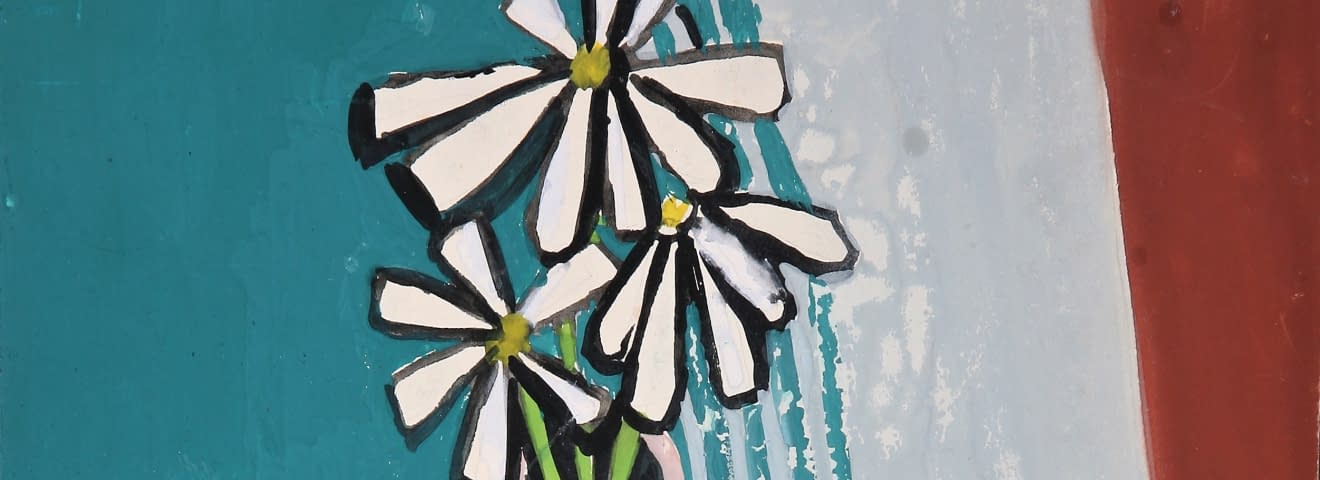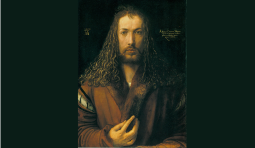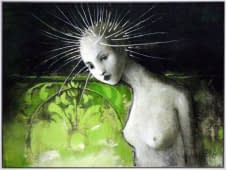Flowers in Painting
Note: Technical terms are shown in italics the first time they are mentioned and explained in a glossary at the end of the text.
The Flower Motif – A Brief Review
Flowers have always been a popular motif in the visual arts. In ancient Egyptian mythology, the lotus flower symbolised the sun and was linked to the concept of creation and rebirth. The white lily was likewise connoted with the fertility and eroticism of the Greek goddess Hera. In the Christian world, the lily was a symbol of purity, innocence and the virgin conception. It refers to the Virgin Mary and was therefore usually depicted in Annunciation scenes.
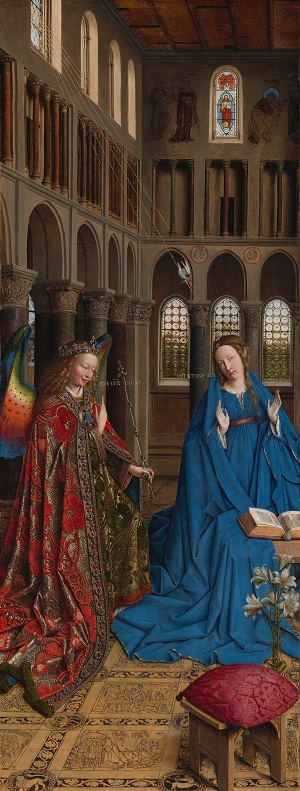
The lily also stands for light, hope and eternal life beyond death. At the same time, it symbolises the story of Christ's Passion. Thus, associations such as life, growth and fertility are inherent in the flower and were therefore connoted with ideas of femininity and sexuality. And what is the language of the flower in painting today? For this, we continue to trace the development of the flower motif.
After they had been depicted in antiquity and in the Middle Ages mostly as a symbol to underline a scene, flowers found their place in paintings as isolated objects in the late Renaissance. The so-called genre of floral still life developed.
Floral still lifes were particularly popular in the Netherlands, where flowers were considered a symbol of luxury in connection with the country's acquired wealth (Golden Age). Magnificent bouquets of flowers were arranged picturesquely, often in combinations that did not exist in reality, as the assembled flowers were in bloom at other times. Through this arbitrary arrangement of bouquets in painting, nature was conquered. The fact that these antipodes of «artificiality» and «nature» stand in opposition to each other is what distinguishes the flower motif: Something natural becomes artificial and, conversely, the artificial represents the natural.
In the Baroque period, the flower still life then reached its «prime». In contrast to the colourful, lively arrangements in which the blossoms outlasted their lifetime as a picture, withering flowers were now painted as educational vanitas still lifes with memento mori motifs. They expressed the transience of earthly life – for people could not escape death even with material wealth.
In the same period, however, flowers were also painted for study purposes because of a growing interest in nature. This interest was nothing new in itself, but globalisation, which took its course through colonialism, inspired European countries to record the flower diversity of the countries they took possession of in paintings. As a result, close observation was combined with artistic ambition in Western art and science.
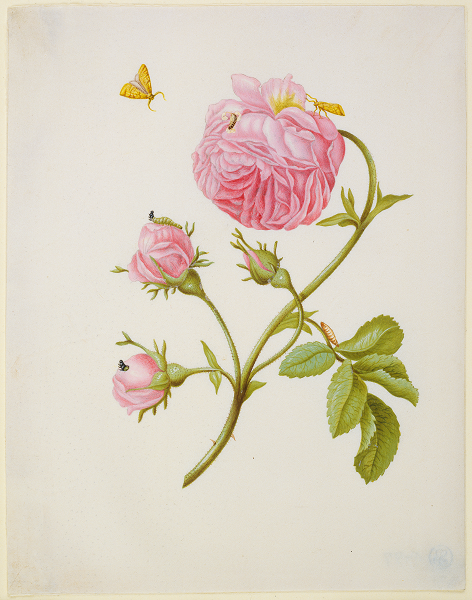
By the 19th century, the painting of landscapes and still lifes had become less important and again turned into a symbolic secondary subject. Now history painting was popular. Although flowers were increasingly depicted again around 1875, they were «only» painted for practice purposes at the still male-dominated academies. The painting of flowers was regarded dismissively as «women's art», as they were seen simply as everyday phenomena to which women could devote themselves in order to pass their time. According to the understanding of the time, artists could demonstrate their skills in history painting and deal with themes in a multi-layered way, which was also reflected formally in the monumental dimensions that were intended to last for eternity. Flower painting, on the other hand, did not represent a rational challenge or “great” art. But with the rise of Realism, landscapes and flower motifs became worthy of art again and could convey complex content. Then, with the flower paintings of Impressionism and Post-Impressionism, it was not far to abstract art. The idealistic and moralistic ideas that were still attached to painting slowly dissolved.
The New Floral Variety in Painting
So, flowers were worshipped on the one hand because of their pure beauty, which gives pleasure and joy on a very personal level. At the same time, as history shows, they were charged with enormous symbolic meaning for that very reason.
If we look at the motif from the Classical Modern period onwards, however, flower motifs became as variable and diverse in their meaning as their occurrences in nature and culture. They took over the canvas in various ways. The motif thus became more and more detached from its religious context, but still retained a certain auratic symbolism, which, however, became increasingly profane, especially when it came to «the feminine». Flowers were still considered a sign of the ability to reproduce, but also a symbol of female lust and desire. The association of sexuality with the flower was thus still maintained and even manifested itself linguistically: in German as well as in English, «loosing one's virginity» is synonymous with the botanical word «defloration». But probably also because flowers always carry something sensual within them. Be it through their diverse and symmetrical shapes, their colours, the scent as well as their surface texture, characteristics that are linked to the «feminine”. This still culturally male-dominated notion ignored the voice of women artists for a long time. For their flower paintings in particular were interpreted as stereotypically «feminine» art. Body and mind thus seemed to be fixed in them, as had been taught for centuries. Flower motifs on women were therefore also interpreted in modernism as hidden Freudian symbols and were supposed to represent vulvas. But perhaps they also simply stood as a contrasting language to the mechanisation and urbanisation of their time, which was reflected artistically above all in Cubism and Futurism, art movements that were correspondingly associated with «masculinity».
The sexual interpretation of flowers can also be linked to an aesthetic theory that has lasted for a long time. Flowers seem to have been attributed to the beautiful rather than the sublime (Immanuel Kant). In this Western distinction between the sublime and the beautiful, a distinction between the «masculine» and the «feminine» is inherent. Flowers were considered purposeless because they were solely beautiful. Consequently, beauty was considered a characteristic of the «feminine». Correspondingly, the sexuality of women was included in treatises on beauty (Sigmund Freud). The feminine as well as the beautiful were things that eluded rationality, and thus also of scientificity, which was considered masculine. Consequently, they were not sublime, but beautiful – and thus sexual. Through this repetitive link with desire, the sensuality of the flower seemed to become increasingly trivial. This can be seen as the moment when the flower liberated itself from this one-sided, feminine sensuality. For flowers enabled artists to interact between this very sensuality, the decorative, the spiritual, the pantheistic and the socio-political. By prominently displaying flowers, people had to look closely and observe – and therein presumably also lies something sensual – to recognise something or someone and to spend time with it. An awareness of the environment was to emerge again, always in connection with the transcendent and the spiritual (in the sense of Wassily Kandinsky). Flowers create a relationship between human beings and nature. They thus symbolise our relationship with the entire cosmos. The human being and the resemblance to the flower, also seen anatomically, its fragility and at the same time the liveliness, similar to the vanitas motifs, seem to mirror ourselves in the flowers – because the flower is in reality neither male nor female, but androgynous.
Through modern depictions of flowers, human beings discovered the abstract in art, an expression of the essence of things, connected with emotions and sensuality and detached itself from the symbolism of female lust and her genitals. Flowers thus offered modern artists a variety of possibilities for expression: they served as a means of practising and experimenting with the material, offered the opportunity for liberated, expressive up to abstract painting or photography, transported a wide range of symbolic content and history, but could also appear as pure decoration and thus serve as a motif for the sake of painting.
So where does the auratic profane lie in the flower paintings? One example is the flower paintings by the American artist Georgia O'Keeffe, whose works are currently on show at the Fondation Beyeler. They are particularly striking because of their close-up presentation. The macro view makes it possible to see fantastic and fascinating plants in a way that would otherwise be impossible for the eye. These take up the entire surface of the painting ground and impress us for this very reason – because this focus on something otherwise so small, with which people rarely deal so precisely and consciously, takes on a new meaning. The presence of the flower can no longer be denied by the oversized representation. This engaging mode of representation comes close to the function of a portrait painting, but at the same time it also acquires an iconic character, similar to that of a saint's icon. Nature is thus declared to be something divine/pantheistic, which can be found in ourselves by referring to the portrait or icon painting. A personal relationship between the plant and the person looking at it, a reflection of the human being in nature, so to speak, is created. By forcing us to adopt a very specific perspective, a space for personal interpretation opens up simultaneously. The large-scale details often take on abstract forms and, as part of the real, in turn open up new views and interpretations. The definitions of aesthetics, our perceptual competence of the world, is expanded and O'Keeffe's painting thereby again establishes similarities to photography: for with close observation and the zoom, it is not far to alienation or abstraction there either.
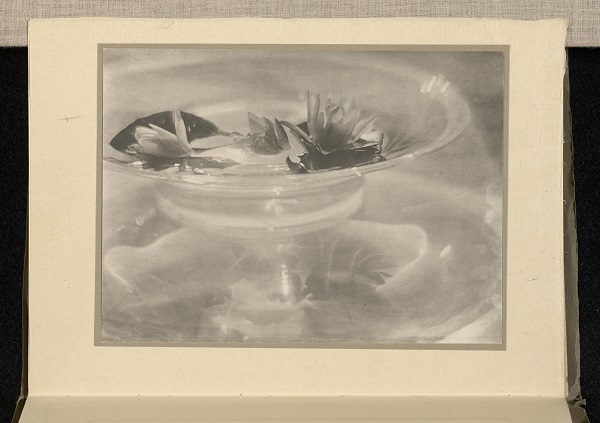
This has the effect that the focus is primarily on the materiality and the shape. Such an isolated view removes any temporality from the picture. So, on the one hand, the flower picture becomes something conscious and autonomous that outlasts its temporal validity; but the fragment also embodies slowness and stagnation, even though in reality time is inevitably linked to photography or the process of painting. The formal enlargement thus creates an emotional and intimate relationship with the object, which at the same time always remains enigmatic and thus auratic. The oversized focus on flowers makes them unmissable and allows us to see our connection to nature.
Flowers can therefore represent much more than just virginity and transience. Despite this, or perhaps precisely because of her knowledge of the historical symbolic language of flowers, the artist Edith Irving-Sommer explored the flower motif and the above-mentioned themes in her painting «Climax of a Tulip». She addresses female desire in an obvious, deliberate and self-confident way with the word «climax» in the picture's title. In doing so, she plays with the withered-looking colour of the flower, with which she alludes to the turning point and changeover of the fertile phase, the climacteric, of biologically female humans. Even when the tulip ages, this does not mean the end of the sexual climax. She testifies to this process by freezing the flower as a painting. The tulip symbolises beauty and sensuality. In this case for that of the ageing woman, qualities that are unfortunately often denied her. The rhetoric of mortality inherent in the flower suggests to women that after a certain age, beauty and desire seem to wither and at some point cease to exist. The tulip depicted thus remains beautiful and sexual despite the ageing process. Irving Sommer thus creates a new narrative that she determines herself. This shows that flower motifs in painting are multi-layered and can be reinterpreted, so they can also address the sexual in a new way.
In Iranian artist Ghazal Ashrafian's painting «This woman is me», the subject matter is quite different. There are flowers on the fabric of her female figure; her dress is covered with them, as is the ground on which she stands. Similar decorative motifs surround the woman. Although the flowers take up space in the work as decorative elements, they are not without purpose. For through them, the artist makes reference to her country of origin, Iran, a country with a rich cultural heritage and wonderful art. The two-dimensionality of the elements in the painting evoke analogies to wallpaper, carpets or tiles – colourful, symmetrical patterns found on fabrics or wall coverings in Iran. The black flowers on which the woman is standing symbolise her grief and tears. Through her work, the artist emphasises on the one hand the decorative nature of flowers, which has always found a place in and inspired human creativity. On the other hand, she also expresses a longing and her relationship with her homeland.
Flowers have undergone an enormous change of meaning. They serve as the object of various themes and open up a wide range of discourses on historical or phenomenological, but also socio-political or gender-specific treatises. Especially in view of mechanisation and digitalisation, the flower motif continues to be a placeholder for a personal debate – also between artist and viewer.
At art24.world you will find exciting flower motifs in the works of our artists. Take a look now at how they present flowers and what they want to tell us through them:
Glossary:
Golden Age: In Dutch history, this refers to an economic and cultural «heyday» that began around 1600 and lasted for about a century.
Vanitas still life: Vanitas (Latin for «vanity», «nothingness») denotes the transience of the earthly. This type of painting developed in the Baroque period. In it, lifeless objects were gathered together, which were understood as symbols of transience, but also symbols of power, wealth and earthly pleasure. They thus had a moralising function. Such Christian art was painted in the «Golden Age» of the Netherlands as well.
Memento mori: The memento mori (Latin for «remember that you have to die») is an artistic motif that was also used in connection with the vanitas still life. It involves objects such as rotting fruit, flowers, flies, pomegranates, skulls. The symbols illustrate the inevitability of death.
History painting: History painting originated in the Renaissance and deals with historical, religious, mythical, legendary or literary material that is depicted in a single condensed moment, thus transferring it into a supra-temporal, ideal space. Historical persons and past acts are portrayed in a glorified way, often in connection with contemporary themes.
Auratic: The aura is understood as the experience of the object with its unique existence. A state that can never be fully grasped and thus carries an uncanny, mystical component. This is always related to perception; accordingly, social tendencies also have an influence on the aura.
The feminine: Characteristics that are socially attributed to a female person.
Freudian symbols: Memory of a symptom, but of which the subject is not aware. Sigmund Freud assumed that unpleasant feelings and affects are translated into a symbolic image. This image can penetrate consciousness, for example via a dream, and be analysed.
Spirit: «The spirit» means the sensual imagination and forms of thinking. This also means a learned perception that has been acquired over centuries.
Pantheistic: Pantheism sees the divine in the structure of the world. According to this, «God» is at the same time nature and embodied in it. There are various forms of this «religion». Often the word «God» is understood as a summary formula for the world and does not mean a personified God.
The spiritual: «The spiritual» in Wassily Kandinsky's writing «On the Spiritual» (1912) means that viewers recognise themselves in the purity of perception, which can no longer be related to the beauty of nature. The writing served to «legitimise» abstract art and accordingly also criticised the ideal imitation of nature as the highest measure of the fine arts. The spiritual is thus that which is embodied in a picture and remains invisible and, according to Kandinsky, «the abstract».
The beautiful: The beautiful is a concept by Immanuel Kant. It describes the feeling for «the beautiful» that is rooted in human nature. It is described as something pleasant, joyful. «The beautiful» is dependent on the «sublime».
The sublime: Immanuel Kant's term denotes something great/sacred. «The sublime» is associated with awe, veneration and respect and therefore triggers not only a pleasant feeling but also shock. He contrasts this with the concept of «the beautiful», of which «the sublime» is a specification. He further divides the human sex into the sublime and the beautiful, which is very problematic. According to Kant, the man is sublime, while the woman is beautiful. As the feeling of «the sublime» is complemented by the feeling of «the beautiful», so the woman complements the man. The male gender stands for seriousness and a deep mind. Women, on the other hand, have a beautiful mind. She should therefore not concern herself with serious matters.
Iconic: Derived from the Greek eikṓn «image», an icon painting refers to an image of a saint. The image of the holy person was intended to inspire awe and create a connection between the viewer and the holy person depicted. They served as a «window to heaven», whereby the person depicted could be worshipped, but the worship was directed at God.
Literature references:
Vischer, Theodora, Fondation Beyeler. (2022). Georgia O’Keeffe. Katalog zur Ausstellung Fondation Beyeler. Hatje Cantz Verlag.
Juul Holm, Michael, Bencard, Ernst Jonas, Tøjner Poul Erik. (2004) The Flower as Image: Araki, ..., Warhol. Humlebæk: Louisiana Museum of Modern Art.
Pigeat Anaël. (2021). GEORGIA O’KEEFFE, FIGURE LIBRE. Paris, France, Art press 2021-09-01 (491), S. 28.
picture credit:
Image 1_Annunciation: Annunciation to Mary, Jan van Eyck, c. 1434/36, oil on canvas transferred to panel, 90.2 cm x 34.1 cm, National Gallery of Art, Washington, Andrew W. Mellow Collection, Photo: National Gallery of Art, Washington.
Image 2_Merian: Bush rose with leaf miner, larva and pupa. 1679, watercolour and opaque colours over transfer on vellum, 18.8 cm x 14.6 cm, Städel Museum, Johann Georg Gambs Collection, Photo: Städel Museum, Frankfurt am Main.
Image_3_ de Meyer_Stieglitz: Baron Adolf de Meyer and Alfred Stieglitz, Still life: Water Lilies, negative 1906; print 1908, photogravure, 16.2 cm x 22.3 cm, photo: Getty Museum.
